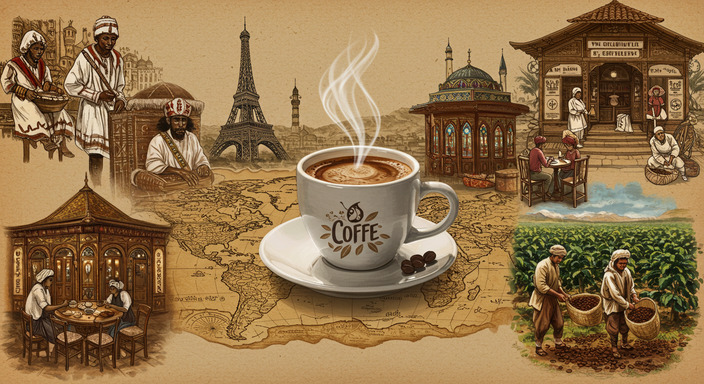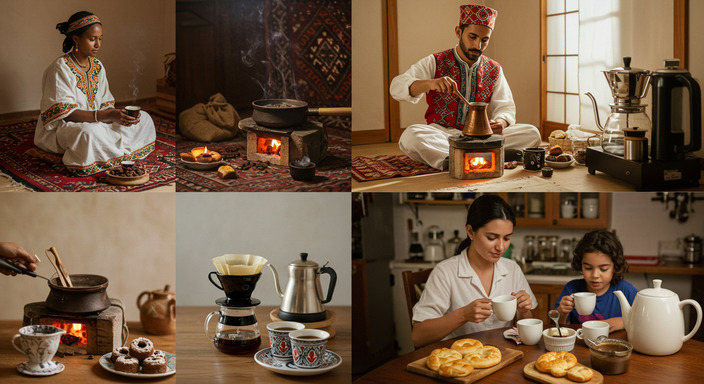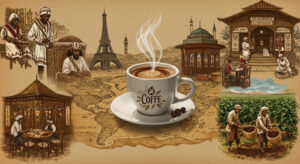The History of Coffee Through the Eyes of Global Traditions
The Ancient Origins of Coffee
The Legend of Kaldi and the Discovery of Coffee
The story of coffee begins with an Ethiopian legend about a goat herder named Kaldi. Around the 9th century, Kaldi noticed his goats became unusually energetic after eating the red berries from a certain shrub. Intrigued, he tried the berries himself and experienced a similar burst of vitality. Monks in the region soon discovered that brewing these berries into a drink helped them stay awake during long hours of prayer. This marked the earliest documented use of coffee as a stimulant.
Early Cultivation in Ethiopia and Yemen
After its discovery, coffee cultivation began in the highlands of Ethiopia, where the plant thrived in the region’s fertile soil and ideal climate. By the 15th century, coffee had crossed the Red Sea into Yemen, where it was cultivated in the port city of Mocha. Yemeni farmers perfected the art of growing and roasting coffee beans, turning the drink into a cherished commodity. The region’s arid conditions made it difficult to grow coffee elsewhere, ensuring Yemen’s dominance in the early coffee trade.
The Spread of Coffee to the Arabian Peninsula
From Yemen, coffee quickly spread across the Arabian Peninsula, where it became an integral part of social and cultural life. By the 16th century, coffeehouses, known as qahveh khaneh, began to appear in cities like Mecca and Istanbul. These establishments became hubs for conversation, entertainment, and intellectual exchange. The popularity of coffee grew so rapidly that it earned the nickname “the wine of Islam”, as it provided a sober alternative to alcoholic beverages, which were prohibited in Islamic culture.
Coffee in the Islamic World
The Role of Coffee in Sufi Rituals
Coffee’s journey in the Islamic world began in the 15th century, where it found a special place in Sufi rituals. Sufi mystics, known for their spiritual practices, embraced coffee as a means to stay awake during long nights of prayer and meditation. The stimulating properties of coffee allowed them to maintain focus and devotion, making it an integral part of their religious ceremonies. This early adoption by Sufis not only elevated coffee’s status but also laid the foundation for its cultural and social significance in the region.
The Rise of Coffeehouses as Social Hubs
By the 16th century, coffeehouses, or qahveh khaneh, began to emerge as vibrant social hubs across the Islamic world. These establishments were more than just places to enjoy a cup of coffee; they were centers of intellectual exchange, debate, and camaraderie. Coffeehouses became the meeting grounds for poets, scholars, merchants, and travelers, fostering a sense of community and cultural exchange. Their popularity spread rapidly, transforming coffee into a symbol of hospitality and social interaction.
The Cultural Significance of Qahwa
In the Islamic world, coffee is often referred to as qahwa, a term deeply rooted in tradition and meaning. Beyond being a beverage, qahwa embodies a rich cultural heritage. It is traditionally prepared in a dallah, a long-spouted coffee pot, and served in small cups as a gesture of welcome and respect. The preparation and sharing of qahwa are steeped in rituals that reflect the values of generosity and connection. This cultural significance has ensured that coffee remains a cherished part of daily life and special occasions across the Islamic world.
Coffee’s Journey to Europe
The Introduction of Coffee to Venice and Beyond
In the 16th century, coffee began its European odyssey, with Venice serving as its gateway. Venetian merchants, renowned for their trade networks, brought coffee beans from the bustling ports of the Middle East. By the early 17th century, Venice had established the continent’s first coffeehouses, known as botteghe del caffè. These establishments quickly became hubs of social interaction, setting the stage for coffee’s spread across Europe.
The Rise of European Coffeehouses and Intellectual Culture
As coffeehouses proliferated in cities like London, Paris, and Vienna, they evolved into more than just places to enjoy a cup of coffee. They became centers of intellectual discourse, where philosophers, writers, and thinkers gathered to exchange ideas. For instance:
- London’s coffeehouses were dubbed “penny universities” for the lively debates they hosted.
- In Vienna, coffeehouses became synonymous with artistic and literary movements.
This coffeehouse culture played a pivotal role in shaping European intellectual and social landscapes.
The Impact of Coffee on European Society and Economy
Coffee’s influence extended beyond culture, leaving a profound mark on European society and economy. The demand for coffee beans spurred global trade, connecting Europe with coffee-growing regions in Africa, Asia, and later, the Americas. Economically, coffee became a lucrative commodity, driving colonial expansion and establishing trade routes that would shape the modern world.
Moreover, coffee’s stimulating effects transformed work habits, particularly among the working class and artisans, who relied on it to increase productivity. This shift contributed to the “caffeinated” pace of the Industrial Revolution.
Coffee in the Americas
The Colonial Expansion of Coffee Cultivation
As European powers expanded their colonial reach in the Americas, they brought with them the practice of coffee cultivation. The tropical climates of regions like the Caribbean and Central America proved ideal for coffee farming. By the 18th century, coffee had become a staple crop in colonies such as Jamaica, Haiti, and Brazil. The Spanish and Portuguese were particularly instrumental in spreading coffee cultivation, leveraging the labor of enslaved Africans to establish vast plantations. This colonial expansion not only transformed the agricultural landscape but also laid the foundation for coffee’s global dominance.
The Rise of Coffee Plantations in Latin America
Latin America emerged as a powerhouse in the global coffee industry during the 19th and 20th centuries. Countries like Brazil, Colombia, and Costa Rica became synonymous with high-quality coffee production. The introduction of modern farming techniques and infrastructure, such as railways, allowed for efficient transportation of coffee beans to international markets. Smallholder farmers and large plantations alike contributed to the region’s reputation for producing some of the world’s finest arabica beans. Today, Latin America remains a vital player in the coffee trade, with its beans cherished for their distinct flavors and aromatic profiles.
The Cultural Integration of Coffee in North America
In North America, coffee evolved from a colonial import to a cultural icon. The American Revolution saw coffee replace tea as the preferred beverage, symbolizing independence and self-reliance. By the 19th century, coffeehouses became hubs of social and intellectual activity, particularly in cities like Boston and New York. The 20th century witnessed the rise of coffee as a daily ritual, with innovations such as instant coffee and the proliferation of diners and cafes. The modern specialty coffee movement has further elevated North America’s coffee culture, emphasizing sustainability, quality, and artisanal brewing methods.
Asian Coffee Traditions
Vietnam: The Bold and Sweet Ca Phe Sua Da
Vietnam’s coffee culture is a testament to resilience and adaptation. Introduced by French colonists, coffee flourished, and ca phe sua da, the iconic iced coffee with sweetened condensed milk, became a national staple. Made with robusta beans—known for their intense, bitter profile—this drink balances strength with creamy sweetness. The preparation is an art:
- A small metal phin filter drips strong coffee slowly over ice.
- Condensed milk adds richness, a legacy of fresh milk scarcity in the past.
- Often enjoyed at bustling street stalls or tranquil lakeside cafés.
Vietnam’s coffee scene is evolving, with third-wave cafés now spotlighting local arabica, but the soul of its tradition remains in every glass of ca phe sua da.
Japan: The Quiet Sophistication of Kissaten
Japan’s kissaten (traditional coffee houses) are sanctuaries of precision and nostalgia. Dating back to the early 20th century, these spaces emphasize slow coffee—hand-dripped pour-overs, siphon brews, and meticulous attention to detail. Key influences include:
- Dark roasts: A preference for deep, smoky flavors, often using Colombian or Ethiopian beans.
- Ambience: Wooden interiors, jazz records, and a focus on solitude and reflection.
- Legacy Many kissaten have operated for decades, preserving pre-war brewing techniques.
Though modern chains dominate, kissaten remain a bridge between Japan’s coffee history and its present, appealing to purists and contemplative drinkers alike.
India: The Spiced Elegance of Filter Coffee
In India, coffee is synonymous with community—and spice. South India’s filter coffee, or kaapi, is a frothy, milky brew made with dark-roasted arabica and chicory, served in a dabara-tumbler set. What sets it apart:
- Chicory blend: Adds earthy depth, a practice born from wartime bean shortages.
- Spiced variations: Some versions infuse cardamom or pepper, nodding to local flavors.
- Ritual: Poured dramatically between vessels to aerate and cool.
Today, India’s coffee scene is booming, with specialty roasters exploring single-origin beans, but the heart of its tradition still beats in the bustling darshinis (quick-service eateries) of Chennai and Bengaluru.
African Coffee Heritage
The Return to Coffee’s Roots: Ethiopia and Kenya
Africa is widely regarded as the birthplace of coffee, with Ethiopia often credited as the origin of the beloved bean. Legends tell of a goat herder named Kaldi, who discovered coffee after noticing his goats’ spirited behavior upon eating the cherries. This ancient connection to coffee has shaped Ethiopia’s culture, where coffee remains a cornerstone of daily life. Similarly, Kenya, with its high-altitude regions and fertile soils, has become renowned for its bright, acidic, and full-bodied Arabica beans. Together, these nations represent the heart of coffee’s heritage.
Traditional Brewing: The Ethiopian Coffee Ceremony
One of the most captivating aspects of African coffee culture is the Ethiopian coffee ceremony, a ritual that transforms brewing into an art form. This ceremonial process involves:
- Roasting green coffee beans over an open flame.
- Grinding the beans using a mortar and pestle.
- Brewing the coffee in a traditional clay pot called a jebena.
- Serving the coffee in small cups, often accompanied by incense and snacks.
The ceremony is not just about the coffee but also about fostering community and connection, making it a deeply social experience.
Coffee’s Role in African Economies and Communities
Coffee is more than a beverage in Africa; it is a lifeline for millions. In countries like Ethiopia and Kenya, coffee farming is a primary source of income for rural communities. The crop supports:
- Smallholder farmers who rely on coffee for their livelihoods.
- Local economies through export revenues.
- Sustainability initiatives that promote environmentally friendly farming practices.
Moreover, coffee plays a vital role in preserving cultural identity, as traditional practices and knowledge are passed down through generations.
Modern Global Coffee Culture
The Rise of Specialty Coffee and Third-Wave Movements
In the 21st century, coffee has transcended its role as a mere beverage to become an art form, a science, and a cultural phenomenon. The third-wave coffee movement, which began in the early 2000s, has revolutionized the way we perceive and consume coffee. This movement emphasizes quality, sustainability, and craftsmanship, focusing on the unique characteristics of coffee beans, their origins, and the meticulous processes involved in brewing. Specialty coffee shops have become hubs of innovation, where baristas are trained like sommeliers, and every cup is a testament to the farmer’s labor and the roaster’s expertise.
How Global Traditions Influence Modern Coffee Trends
Modern coffee culture is a beautiful tapestry woven from threads of global traditions. From the centuries-old Ethiopian coffee ceremony to the Italian espresso culture, these traditions have shaped the way we enjoy coffee today. For instance, the Nordic countries’ emphasis on light roasts has influenced the global preference for nuanced, acidic flavors, while Japan’s meticulous attention to detail has inspired the precision brewing techniques now popular worldwide. The exchange of knowledge and practices across borders has enriched the coffee experience, creating a dynamic and interconnected global community of coffee lovers.
The Future of Coffee in a Connected World
As the world becomes increasingly interconnected, the future of coffee is both exciting and challenging. Sustainability will play a crucial role, with a growing emphasis on ethical sourcing, carbon-neutral practices, and innovative farming techniques. Technology will continue to evolve, offering tools for better brewing and deeper consumer engagement. Moreover, the global dialogue about coffee will expand, fostering a greater appreciation for its cultural and economic significance. In this connected world, coffee will remain a unifying force, bridging cultures and enriching lives.
FAQ
- What is third-wave coffee? Third-wave coffee is a movement that focuses on high-quality, artisanal coffee, emphasizing the unique flavors of beans and the craftsmanship involved in brewing.
- How has global tradition influenced modern coffee culture? Global traditions, such as the Ethiopian coffee ceremony and Italian espresso culture, have shaped modern trends, influencing everything from brewing techniques to flavor preferences.
- What does the future hold for coffee? The future of coffee will likely focus on sustainability, innovation, and a deeper global appreciation of coffee’s cultural and economic importance.














Post Comment